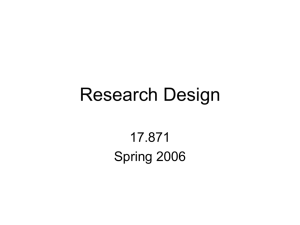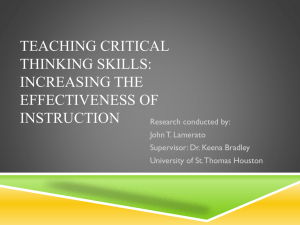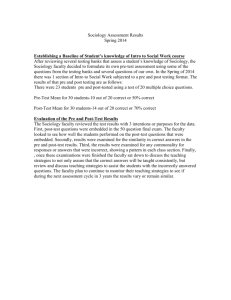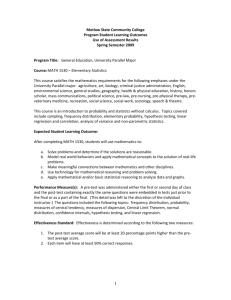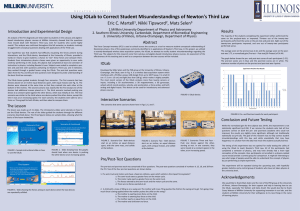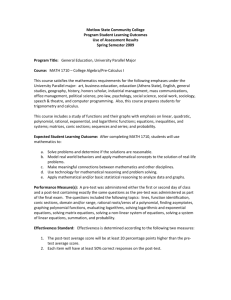Research Design
advertisement
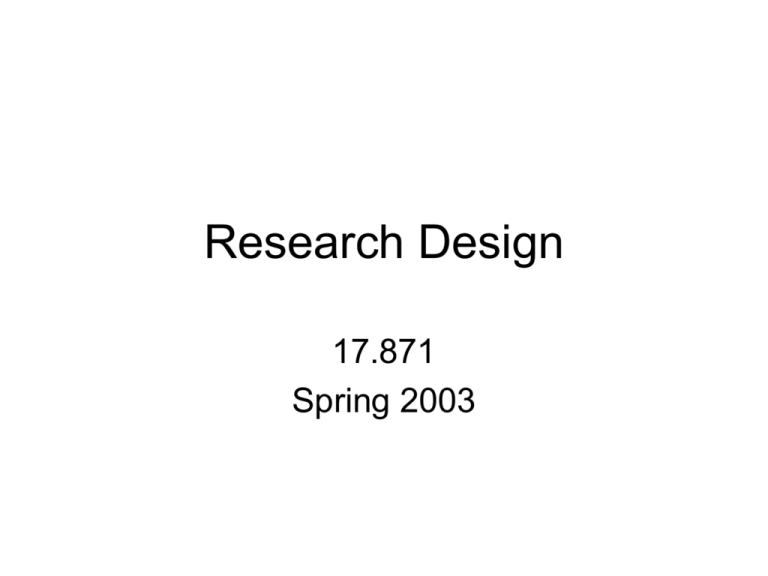
Research Design 17.871 Spring 2003 General Comments • The road map of political science • Different ways of doing political science research • Major components of research designs • Designing research to ferret out causal relationships • Social science vs. natural science/engineering The Road Map Philosophy Normative Positive Causal Correlational Descriptive Different Ways of Doing Empirical Research • Interpretive • Small-n case study – Haphazard – Structured • Large-n statistical analysis • Interactions among these ways Major Components of Research Designs • Research question • Theory • Data Research Question • Important – Not too general – Not too specific – Just right • Contribute to literature – How to tell: Social Sciences Citation Index – http://libraries.mit.edu/get/webofsci – E.g.: effect of redistricting on congressional election results • Search for Cox & Katz, “The Reapportionment Revolution and Bias in U.S. Congressional Elections,” AJPS 1999 Theory • Definition: A general statement of a proposition that argues why events occur as they do and/or predicts future outcomes as a function of prior conditions • General/concrete trade-off • Desirable qualities of theories – Falsification (Karl Popper) – Parsimony (Occam’s razor) Data • Terms – Cases – Observations – Variables • Dependent variables • Independent variables – Units of analysis • Mapping between the abstract and concrete (we’ll come back to this) – Measures – Indicators Causality • Definition of causality • Problems in causal research • Side trip to Campbell and Stanley Definitions of Causality • Logical – A causes B if the “presence” of A is a sufficient condition for B. • Experiential – A causes B if B occurs following the “exogenous” introduction of A – When does exogeneity occur? • Positive example: “ethnic” names on resumes • Negative example: campaign spending The Biggest Problem in Causal Research • Establishing the exogeneity of “causes” How to Establish Causality • Donald Campbell and Julian Stanley, Experimental and Quasi-Experimental Designs for Research (1963) Design types • • • • • • One-shot case study One-group pre-test/post-test Static group comparison Pre-test/post-test with control group Solomon four-group design Post-test only experiment [Running example: racial discrimination in resumes] One-shot Case Study • Summary: X O or O • Journalism • Common sense • “of no scientific value” X One-group Pre-test/Post-test • Summary: O X O • Better than nothing • Standard way of doing most research • Big problems – No comparison group – No random assignment • Encourages “samples of convenience” Static group comparison • Summary: X O1 ----------O2 • This is most cross-sectional & correlational analysis • Problems – Selection into the two groups – No pre-“treatment” measurement Pre-test/Post-test Control Group • Summary: R O1 T X O2T -------------------------------R O1 C O2C • Effect of treatment: [O2T – O1T] – [O2C – O1C] • This is the classic randomized experiment • Problem: “Hawthorne effect” Solomon Four-Group Design • Summary: R R R R O O X X O O O O • Allows you to control for the effect of the experiment itself Post-test only experiment • Summary: R X O R O • No prior observation (assume O1T = O1C) • Classical scientific and agricultural experimentalism Where do standard political science studies fall among the Stanley/Campbell designs? • One-shot case study – Little scientific value, but may be descriptively useful • One-group pre-test/post-test – Often used in policy analysis – Only justified as a “best design” if there are ethical or other constraints • Static group comparison – Correlational studies by far the most common “scientific” social science research • Pre-test/post-test with control group – “Real” experiments uncommon, but growing in frequency – “Quasi-experiments” growing more rapidly • Solomon four-group design – Don’t recall ever seeing this • Post-test only experiment – Leads to weaker statistical tests Social Science vs. Natural Science and Engineering • Reductionism – Degree of reductionism • Implications – Measures of association weak – Aggregates often better predictors • Why we have statistics
